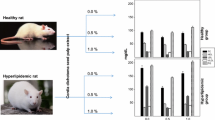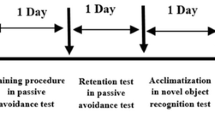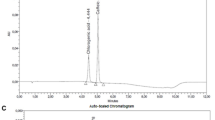Abstract
We have investigated the effects on blood and liver lipoperoxide levels of turmeric, a potent antioxidant (from the rhizome of Curcuma Longa) which is extensively used as a food additive in India and other Asiatic and Central American countries. This study was performed on female Swiss mice that were 17±2 week old at the start of the experiment. A control group of 20 mice was fed the standard diet and another 20 animals received in their food 4 mg/Kg mouse/day of hydroalcoholic extract of turmeric, equivalent to 0.4 mg/Kg mouse/day of the phenolic antioxidant curcumin. This concentration is similar to that used in our current testing of turmeric on human subjects. The effects of the treatment were determined weekly by measuring food intake, body weight and muscular and CNS function (evaluating performance of mice subjected to string and T-maze tests). After four weeks of treatment, the mice were sacrificed and blood and liver samples were removed for determination of lipid peroxidation (measuring malondialdehyde content by the thiobarbituric acid method).
The treatment with turmeric did not result in any toxic effects on the above physiological, behavioral and biochemical parameters. On the other hand, our data show a decrease in the level of both plasma and liver lipid peroxides. In our opinion, these preliminary data justify further animal investigations on the effects of treatment with this antioxidant not only on lipid peroxidation, but also on atherogenesis and senescence, since, according to the radical theory of aging, they man be linked to peroxidative changes.
Similar content being viewed by others
References
Harman, D.: Aging: a theory based on free radical and radiation chemistry. J. Gerontol., 11:298–300, 1956.
Harman, D. Free radical theory of aging: role of free radicals in the origination and evolution of life, aging and disease processes, in Free Radicals, Aging and Degenerative Diseases, edited by Johnson, J.E., Jr., Walford, R., Harman D., and Miquel, J., New York, Alan R. Liss, 1986, pp. 3–49.
Harman, D.: Free radical theory of aging: history, in: Free Radicals and Aging, edited by Emerit, I., and Chance, B., Basel, Birkhauser Verlag, 1992, pp. 1–10.
Miquel, J., Economos, A.C,, Fleming, J., Bensch, K.G., Atlan, H. and Johnson, J. E. Jr.: Mitochondrial role in cellaging. Exp. Gerontol.; 15: 575–591, 1980.
Fleming, J.E., Miquel, J., Cottrell, L.S., and Yengoyan, L.S.: Is cell aging caused by repiration-dependent injury to the mitochondrial genome? Gerontology 28: 44–53, 1982.
Miquel, J.: An update on the mitochondrial-DNA mutation hypothesis of cell aging. Mutation Res. 275: 209–216, 1992.
Miquel, J. and Blasco, M.: Aging as a mitochondrial-energy defficiency disease. Facts and Res. in Gerontol., 8: 28–34, 1994.
Harman, D.: Free radical theory of aging: nutritional implications. Age 1:145–152, 1978.
Weber, H., and Miquel, J.: Antioxidant supplementation and longevity, in Nutritional Aspects of Aging, edited by L.H. Chen, Boca Raton, CRC Press, Vol. 1, 1986, 99. 42–49.
Ammon, H.P.T.: Pharmacology of Curcuma Longa. Planta Med. 57: 1–7, 1991.
Toda, S.: Natural antioxidants. III. Antioxidative components isolated from rhizome of Curcuma Longa L. Chem. Pharm. Bull. 33: 1725–1728, 1985.
Aruna, K. and Sivaramakrishnan, V.M.: Plant products against cancer, Indian J.Exp. Biol. 28: 1008–1011, 1990.
Azuine, M.A., and Bhide, S.V.: Chemopreventive effect of turmeric against stomach and skin tumors induced by chemical carcinogens in Swiss mice. Nutr. Cancer 17: 77–83, 1992.
Soni, K.B., Rajah, A., and Juttan, R.: Reversal of aflatoxin induced liver damage by turmeric and curcumin. Cancer Letters 66:115–121, 1992.
Masuda, T., Isobe, J., Jitoe, A., and Nkataini, N.: Antioxidative curcuminoids from rhizomes of Curcuma xantorrhiza. Phytochemistry 31: 3645–3647, 1992.
Jitoe, A., Masuda, T, Tengah, I.G.P., Suprapta, D.N., Gara, I.W. and Nakatani, N.: Antioxidant activity of tropical ginger extracts and analysis of the contained curcuminoids. J. Agrc. Food Chem. 40: 1337–1340, 1992.
Sharma, O.P.: Antioxidant activity of curcumin and related compounds. Biochem. Pharmacol., 25: 1811–1812, 1976.
Miquel, J. and Blasco, M.: A simple technique for evaluation of vitality loss in aging, mice, by testing their muscular coordination and vigor. Exp. Gerontol., 13: 389–396, 1978.
Ohkawa, H., Ohsihi, N. and Yagi, K., Assay for lipid peroxides in animal tissues by thiobarbituric acid reaction, Anal. Biochem., 95: 351–358, 1979.
Lowry, O.H., Rosenbrough, N.J., Farr, A.L. and Randall, R.J., Protein measurement with the Folin phenol reagent, J. Biol. Chem., 193: 265–275, 1951.
Sambaiah K., Katankumar S., Kamanna VS., Satyanarayana MN., Rao MVL.: Influence of turmeric and curcumin on growth, blood constituents and serum enzymes in rats. J Food Sci. Technol., 19: 187–190, 1982.
Bhavani T.N., Toxicity studies on turmeric (Curcuma Longa): Acute toxicity studies in rats, guinea pigs and monkeys, Indian J. Exp. Biol., 18: 73–75, 1980.
Lippman, R.D.: Free radical-induced lipoperoxidation and aging, in Handbook of Free Radicals and Antioxidants in Biomedicine, edited by Miquel, J., Quintanilha, A., and Weber, H. Boca Raton, CRC Press, Vol. 1, 1989, pp. 187–197.
Henning, B., and Chow, C.K.: Lipid peroxidation and endothelial cell injury: implications in atherosclerosis. Free Rad.Biol. Med. 4: 99–106, 1988.
Kleinveld, H.A.; Demacker, P.N.M. and Stalenhoef, A.F.H.: Comparative study of the effect of low-dose vitamin E and Probucol on the susceptibility of LDL to oxidation and the progression of atherosclerosis in Watanabe heritable hyperlipidemic rabbits. Arterioscler. Thromb. 14: 1386–1391, 1994.
Author information
Authors and Affiliations
About this article
Cite this article
Miquel, J., Martinez, M., Díez, A. et al. Effects of turmeric on blood and liver lipoperoxide levels of mice: Lack of toxicity. AGE 18, 171–174 (1995). https://doi.org/10.1007/BF02432632
Issue Date:
DOI: https://doi.org/10.1007/BF02432632




